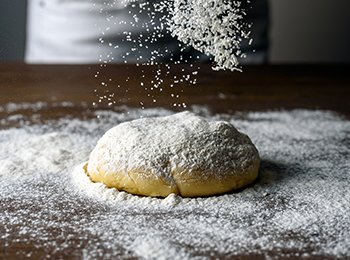Enzymes: Breaking Barriers and Elevating Functionalities of Starch การข้ามผ่านอุปสรรคและยกระดับคุณสมบัติการทำงานของแป้งด้วยเอนไซม์
1687 Views |

Enzymes: Breaking Barriers and Elevating Functionalities of Starch
การข้ามผ่านอุปสรรคและยกระดับคุณสมบัติการทำงานของแป้งด้วยเอนไซม์
by. ดร. วลัยพร ทิมบุญธรรม
Walaiporn Timbuntam, Ph.D.
Assistant Manager of Technical Service
Amano Enzyme Asia Pacific Co., Ltd.
แป้งเป็นหนึ่งในพอลิเมอร์ที่มีมากที่สุดในธรรมชาติ อย่างไรก็ตามคุณสมบัติพื้นฐานของแป้งตามธรรมชาตินั้นไม่เหมาะสำหรับการนำมาผลิตเป็นผลิตภัณฑ์อาหารบางประเภท เนื่องจากแป้งตามธรรมชาติที่ยังไม่ผ่านการดัดแปรจะมีการรีโทรเกรด ทำให้ความคงตัวระหว่างการเก็บรักษาต่ำและมีเนื้อสัมผัสที่ไม่พึงประสงค์ เพื่อสามารถใช้ประโยชน์จากแป้งได้อย่างเต็มที่จึงมีการดัดแปรโครงสร้างของแป้งเพื่อเพิ่มคุณสมบัติเชิงบวก ลดข้อบกพร่อง และยังเพิ่มคุณสมบัติให้เหมาะสมกับการใช้งาน เช่น การละลาย การเกิดเจล การทนการย่อย การสร้างฟิล์ม การยึดเกาะ และการห่อหุ้มสาร เป็นต้น โดยบทความนี้ขอแนะนำ 2 นวัตกรรมในการดัดแปรแป้งด้วยเอนไซม์ เพื่อยกระดับคุณภาพของผลิตภัณฑ์จากแป้ง เช่น ข้าวสุก โมจิ และเนื้อจากพืช
นวัตกรรมแรกคือ การดัดแปรแป้งด้วยเอนไซม์ 4-α-glucanotransferase ซึ่งเป็นเอนไซม์ที่ถ่ายโอนน้ำตาลไตรโอส (Triose) จากสายพอลิเมอร์ของ 1,4-α-D-glucan ไปยังตำแหน่งใหม่ในคาร์โบไฮเดรตตัวรับ เช่น กลูโคสหรือ 1,4-α-D-glucan อื่นด้วยการเชื่อมต่อด้วยพันธะ1,3-α-D-glucosidic ปฏิกิริยานี้จะเปลี่ยนแป้งเดิมให้เป็นพอลิเมอร์กลูโคสที่มีโครงสร้างการแตกแขนงสูง (ภาพที่ 1) และทนทานต่อการรีโทรเกรด ผู้ผลิตอาหารสามารถใช้ 4-α-glucanotransferase เพื่อลดการแข็งตัวของข้าวสุก โมจิ และขนมปังหลังการแช่เย็นหรือแช่แข็ง เอนไซม์นี้ทนต่อความร้อนได้ จึงสามารถทำงานได้อย่างมีประสิทธิภาพในแป้งโดเมื่อเติมก่อนนึ่งหรืออบ นอกจากนี้ 4-α-glucanotransferase ยังสามารถใช้ร่วมกับเอนไซม์อีก 2 ชนิด ได้แก่ cyclodextrin glucanotransferase และ pullulanase เพื่อผลิตพอลิแซ็กคาไรด์ที่ทนต่อการย่อย
นวัตกรรมที่สองนั้นเกี่ยวการสร้างหรือผลิตไซโคลเดกซ์ทริน (Cyclodextrin; CD) ด้วย cyclomaltodextrin glucanotransferase หรือ cyclodextrin glycosyl transferase (CGTase) เอนไซม์ชนิดนี้สามารถกระตุ้นปฏิกิริยาได้ถึง 4 แบบ ได้แก่ ปฏิกิริยาการเกิดวงแหวน (Cyclization) ปฏิกิริยาควบคู่ (Coupling) ปฏิกิริยารีดักชัน (Disproportionation) และ ปฏิกิริยาไฮโดรไลซิส (Hydrolysis) ในผลิตภัณฑ์อาหารจากแป้ง เช่น ผลิตภัณฑ์เบเกอรี ขนมปัง แป้งโด และพาสต้า การดัดแปรโครงสร้างของแป้งให้เป็นไซโคลเดกซ์ทรินบางส่วน ส่งผลให้ผลิตภัณฑ์เหล่านั้นไม่เกิดการแข็งตัวและเพิ่มอายุการเก็บ นอกจากนี้การดัดแปรโครงสร้างของแป้งให้เป็นไซโคลเดกซ์ทรินยังช่วยลดระดับน้ำตาลในเลือดหลังจากการบริโภคอาหารจากแป้งนั้นๆด้วย ทำให้ผลิตภัณฑ์อาหารจากแป้งที่ผ่านการดัดแปรด้วยเอนไซม์นี้เหมาะสำหรับผู้บริโภคที่ใส่ใจสุขภาพเป็นอย่างยิ่ง
Starch is one of the most abundant renewable biopolymers in nature, however, the properties of native starches are inherently unsuitable for a wide range of products and applications. This is because unmodified starches possess characteristics related to retrogradation, low storage stability, and undesirable texture. To fully utilize starch, it is structurally modified to enhance its positive attributes, minimize its defects, and even provide novel functionalities for specific applications, such as solubility, gelation, gel rheology, digestibility, film formation, adhesiveness, and encapsulation. In this article, two innovations will be introduced for improving the quality of starch for novel products including but not only cooked rice, frozen mochi, and meat analogues.
The first innovation is 4-α-glucanotransferase, an enzyme that transfers a segment of glucose polymer - triose unit, to a new position on a carbohydrate receptor such as glucose or 1,4-α-D-glucan and connect them with 1,3-α-D-glucosidic linkage (Figure 1). Thus, this reaction converts starch into a highly branched structure that resistant to retrogradation. 4-α-glucanotransferase is applied to reduce hardening during storage in cooked rice, frozen mochi, and bread. The enzyme treated dough would have a longer-lasting softness than ordinary dough. 4-α-glucanotransferase can also be used in combination with two more enzymes, cyclodextrin glucanotransferase and pullulanase, to produce indigestible polysaccharides.
The second innovation is cyclomaltodextrin glucanotransferase, also known as cyclodextrin glycosyl transferase (CGTase) to produce cyclodextrin. CGTases can catalyze up to 4 reactions: cyclization, coupling, disproportionation, and hydrolysis. In starch products, cyclodextrin modifies the starch structure making the finished products to be anti-staling and increasing the shelf-life, such as in bakeries, breads, doughs, and pasta. Furthermore, applying cyclodextrin in food products reduces the blood glucose elevation after consuming starch making the enzyme treated products suitable for health-conscious consumers.






